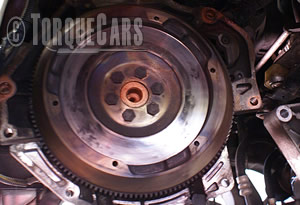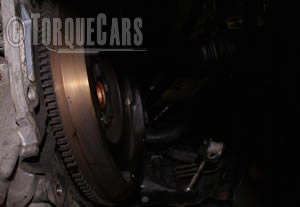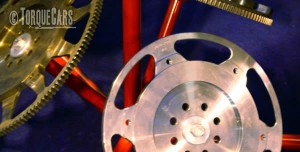Flywheel lightening and its impact on engine performance.
"No Fly(wheels) on us."
 Lightening the flywheel – the flywheel works in a similar way to the wheel in the toy cars you used to rev up and release and let it zoom off. The heavy wheel located between the engine and the gearbox builds up rotational force with speed and momentum.
Lightening the flywheel – the flywheel works in a similar way to the wheel in the toy cars you used to rev up and release and let it zoom off. The heavy wheel located between the engine and the gearbox builds up rotational force with speed and momentum.
Effectively storing the energy and helping the car resist changes in engine speed - good for cruising at a steady speed but bad when you need a fast engine response.
Drawbacks – it takes effort to get the wheel rotating and stops the engines revs increasing or slowing down quickly. A lighter wheel takes strain off the engine and allows the engine to rev more freely, as a bonus as there is less weight the engine is able to release more power.
You’ll notice a race-tuned engine increases and decreases revs a lot more quickly than a standard engine. The big downside to a lighter flywheel is that engine momentum or inertial spin is reduced – most noticeably on a hill.
Whereas the momentum in the engine is maintained with a heavy flywheel the momentum is reduced and the hill has a much more direct effect on the engine output. Best used in a race situation where the track is flat with a demand for fast engine speed changes and the engine has been tuned to output power matching the flywheel capacity (high revving).
The driver will often heel and toe gear change and braking taking advantage of the greater responsiveness from the engine. Various weights of flywheel are available allowing you to get the best torque/free revving capabilities. 
Different grades of flywheel are available for different applications, and for street cars you don't want to go too light or your tick over may suffer. Why not have a chat with our members in the TorqueCars car forums to discuss your required application. If you feel tempted to make your own light weight flywheel by drilling holes in it TorqueCars urge you to reconsider, the slightest imbalance can cause major issues.
Even standard flywheels that are put into cars are balanced. A wobble in the flywheel can have disastrous consequences on the engine and will reduce your red line significantly. The faster the RPM the greater the effects of a wobble will be. A flywheel that snaps will send a buzz saw of metal through the car potentially causing injury to driver or passenger.
Off the shelf lightened flywheels are carefully balanced and made of various alloys blended for strength and lightness - some even come with holes and gaps like an alloy wheel.
If you are replacing a clutch you may just as well get the flywheel sorted while you are at it.
Dual Mass flywheels have two separate surfaces which are connected via a spring. The spring acts to dampen the rotational differences in acceleration and deceleration. They help to smooth out the power taking up vibration from the engine and reducing the risk of reversion in 4 cylinder engines and smoothing out diesel engines.
A DMF can be a pain when they start to go wrong, and some of our members are replacing them with solid and lighter flywheels.
If you are serious about lightening bits and pieces to get a free revving engine try a carbon fibre drive shaft. These will rotationally flex more that their metal counterparts and reduce strain on the engine. If a metal drive shaft breaks you will soon know about it as parts are thrown through the car! A carbon fibre one is stronger but if it does break it will 'broom' into 'harmless' fibres and little damage will be done to the car.
For more tips and advice on car tuning and modification we suggest you join our very friendly modified car forum and get some specific tips and advice for your car and swap ideas with our enthusiasts.
If you liked this page please share it with your friends, drop a link to it in your favourite forum or use the bookmarking options to save it to your social media profile.
Check out TorqueCars new YouTube channel, and see their awesome new content...
Feedback
Please use our forums if you wish to ask a tuning question, and please note we do not sell parts or services, we are just an online magazine.
Help us improve, leave a suggestion or tip

